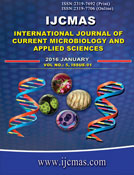


 National Academy of Agricultural Sciences (NAAS)
National Academy of Agricultural Sciences (NAAS)

|
PRINT ISSN : 2319-7692
Online ISSN : 2319-7706 Issues : 12 per year Publisher : Excellent Publishers Email : editorijcmas@gmail.com / submit@ijcmas.com Editor-in-chief: Dr.M.Prakash Index Copernicus ICV 2018: 95.39 NAAS RATING 2020: 5.38 |
The aim of study was to determine the commonly encountered pathogens in pus samples along with their antibiotic susceptibility pattern. This study was conducted from January 2014 to May 2014, in VIMS, MCH central lab. Pus samples received were processed and identification was done by standard protocols. Antibiotic susceptibility test was done by Kirby Bauer disc diffusion method. MRSA detected as per CLSI guidelines. Out of 500 pus samples received for culture and sensitivity, 280 (56%) cases yielded positive culture, 195(39%) cases remained sterile. Among the 280 culture positive pus samples, 271 yielded pure bacterial isolates and 9 yielded two organisms. Among the remaining 25 samples, 16 (3.2%) samples yielded either contaminants/ commensals, 4 (0.8%) yielded Candida spp and 5(1%) showed polymicrobial growth. Staphylococcus aureus was the most common isolate followed by Klebsiella spp and E.coli. Methicillin resistance in S. aureus was found to be 53.96% (68). Among the Gram positive isolates, vancomycin and Ampicillin were the most susceptible drugs whereas among the Gram negative isolates the most susceptible drugs were aminoglycosides. Majority of the wounds were infected with a single organism so, proper management of pus infection with the appropriate antibiotic must be implanted and emphasized to minimize emergence of drug resistant bacteria.
 |
 |
 |
 |
 |